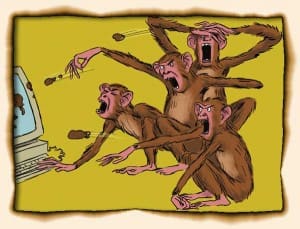I can’t decide if this is one of those “sign of the deteriorating times” type stories, wherein I get to pontificate about how the free-for-all, no insult too depraved, “culture” of the internet has led to yet another sad incident …
…or if it’s a function of the pressures being put on start-ups by the generally shitty global economy, which is starting to incite people into truly depraved acts of violence…
But either way, it was shocking & sad to read that TechCrunch’s Michael Arrington announced today that he has been the victim of death threats, and now this:
Yesterday as I was leaving the DLD Conference in Munich, Germany someone walked up to me and quite deliberately spat in my face. Before I even understood what was happening, he veered off into the crowd, just another dark head in a dark suit. People around me stared, then looked away and continued their conversation.
(snip)
Something very few people know: last year over the summer an off balance individual threatened to kill me and my family … Seeing my parents fear for their lives and not understand how or why their son was in this position changed me, made me a much less forgiving person in general.
Around the blogosphere, this has shocked and appalled other bloggers, some of whom might now (justifiably) wonder if a post of theirs might inspire some violent borderline personality into staking out their house.
Meanwhile, in today’s LA Times, this article about the prevalence of what has come to be known as “snark” in online culture, in a review of a book by the same name by New Yorker film critic David Denby. His take on why this mode of communication (otherwise known as GD&R – for “Grin, Duck and Run”) has become so prevalent:
The Internet is the greatest revolution in democratic practice since popular suffrage. Everyone knows that, and I am just as dependent onthe Internet as anyone else. In the wake of a democratic revolution like that, there’s both an enormous explosion of information and expression, much of it useful or fun, and also an explosion of pent-up rage, social anguish, resentment, bilious, other-annihilating nastiness, prejudice and all the rest of the dark side. If that stuff is destroying conversation threads, screwing up people’s…
…reputations, spreading around unchecked rumor or just snark, it’s worth pointing to it and saying, “Stop lousing up my revolution.†The point of the book is to protect the best kind of humor by criticizing the worst.
…of course, the Times itself has been guilty of – well, shall we say – vivid off-the-cuff commentary itself.
Still, the larger point here is one that is important. In all my stops as a New Media consultant in the last few years, the one issue that animates the local reporters/editors the most is the attacks on them by anonymous internet trolls.
Arrington says that:
On any given day, when I care to look, dozens of highly negative comments are made about me, TechCrunch or one of our employees in our
comments, on Twitter, or on blogs or other sites. Some of these are appropriately critical comments on things we can be doing better. But
the majority of comments are among the more horrible things I can imagine a human being say.

Actress Rebecca Schaeffer was murdered by an obsessed fan who tracked her down, showed up at her doorstep, and shot her in the heart.
Even a cursory search confirms that Arrington takes his shots. This is the Dark Side of internet fame. You can see it in the message boards, in the comments section on any YouTube video that reaches a certain level of popularity.
Back in 1989, one of the very first celebrity stories I had to cover in Los Angeles, remains one of the saddest & most disturbing stories. The murder of Rebecca Shaeffer, a lovely young actress by obsessed stalker Robert Bardo. I can see some clear parallels between that case, and the way that online attacks are escalating into offline violence.
This was a murder that really changed things in Los Angeles; the DMV rules were changed so that you could no longer get someone’s address by merely doing a search on DMV records to get the address off their driver’s license. And the Threat Assessment Department of the LAPD was formed, at least in part, in response to this murder.
One of the things that I learned from covering that case (other than that it sucks to be a reporter tasked to go to a funeral and try to get quotes from sobbing family members), is that wackos and obsessed fans follow an escalating behavior pattern. They start making threats, at first rather timidly. As the response to their threats fails to completely shut them down or punish them enough, they then begin to escalate their attack patterns.
The next stage – the one that Arrington is at, I fear – is what the LAPD shrinks called, “the humiliating encounter.” Basically, the stalker has an encounter with the person they are harassing that results in humiliation – either for the victim (they spit on their face) or the stalker (the studio security guards grab him, handcuff him, and frogmarch him off the lot).
In any case, this encounter then becomes the focus of whirling obsession for the next interval. The stalker sits and broods, going over the encounter in his head, over and over again, fantasizing about what he would have done differently, inventing a whole new encounter … only this next one will be far darker, far more violent.
There is going to have to be a fundamental shift in the way conversations are conducted on the internet. If a tech blogger – not someone in the political sphere, where the contentious nature is well-known – has to take a month off & flee to a beach to be able to deal, then clearly, the writing is on the wall.
This paragraph is probably going to become much more important in the years to come:
In California, under the stalking laws passed after this attach, a stalker is defined as “someone who willfully, maliciously and repeatedly follows or harasses another victim and who makes a credible threat with the intent to place the victim or victim’s immediate family in fear of their safety.” There must be at least two incidents to constitute the crime and show a “continuity of purpose” or credible threat.
UPDATE:
Paul Boutin, over at The Industry Standard, says that the hating has been growing for quite a while:
The most common accusation was that TechCrunch sold endorsements of startups, either in exchange for advertising buys on the site, or for outright cash payments.
This is important: None of these claims ever checked out. Sources would claim to know someone who knew something, but these mystery witnesses never showed up to tell their stories to a reporter. Arrington’s success, both as a blog-era publisher/writer and a startup businessman, inflames less successful entrepreneurs and journalists with off-the-scale envy. How does he do that?

